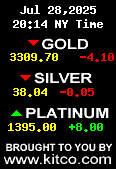Precious metals market analyst Jeff Nichols reckons that gold remains in a bull market and will hit new records again this year, but the path is unlikely to be a smooth one. He notes that gold has enjoyed a long and enviable climb, rising some 380 percent from a cyclical low near $255 in 2001 to an all-time high just over $1,225 in early December last year and he suggests the bull market still has a long way to go, both in magnitude and duration.
Thus he anticipates that the gold price will hit $1,500 an ounce - or higher - during 2010 up more than 35% from its 2009 close.
But that's not all. He feels there is more to come before the yellow metal peaks. Looking further ahead he suggests that an ongoing bull market will carry the price to a cyclical high of $2,000 or more and feels the probability of the yellow metal hitting $3,000 or more in the next few years is rising as the U.S. is, in his view, heading for years of stagflation.
Nichols' views are certainly not unique, and there are plenty of detractors around - notably Nouriel Roubini (Dr. Doom) who has received a fair amount of publicity on his bearish take on the gold price. But the gold bulls in general reckon that he, and many others, do not understand gold and its long history as a monetary metal, which has stood the test of time as a wealth protector in times of economic strife and uncertainty.
The other factors which Nichols feels will help lead to the big price increases in gold over the next few years are what he describes as "a rising secular expansion of investor participation", together with continuing reserve diversification by Central Banks due to what he feels is an "irreversible erosion of the U.S. dollar as the single dominant reserve asset and denominator of much world trade."
"As a result of these secular developments, over the next decade and beyond, the long-run average price of gold (stripping away the major cyclical bull and bear market swings) will be considerably higher than past experience would suggest . . . and considerably higher than many analysts and investors would dare imagine" says Nichols.
But Nichols also reckons the gold price rise will be far from a smooth one with changing expectations about U.S. interest rates and monetary policy and short term fluctuations in the perception of the strength or weakness of the U.S. dollar likely to trigger occasional reversals - notably statistics indicating improvements in the U.S. economy, or accelerating inflation leading to tightening of interest rate policy which could briefly push the dollar higher or lower with a corresponding impact on the gold price.
There are a myriad of financial uncertainties out there at the moment which have been detailed in these columns in the past which could have either a positive or negative impact on precious metals prices in the short term and Nichols reckons the dips will provide some good buying opportunities.
He goes on to reiterate his views that gold is definitely not in a bubble situation (after all base metals prices rose far more steeply in 2009 than gold did despite the bubble talk).
He feels gold's strength is built on solid fundamentals - fundamentals that gold bears, among them a number of eminent economists, fail to recognise. These include: Continuing expansionary U.S. monetary and fiscal policies; strong continuing Central Bank demand for gold as a reserve diversifier; continuing expansion of investor interest; a continuing decline in world gold mine production which he reckons will continue for at least another five years before high gold prices have been sufficient to stimulate new production. Finally he looks to expanding and evolving geographic markets for gold, particularly in the East where the combination of a traditional cultural interest in gold is boosted by rising incomes and wealth.
In this respect Nichols pays specific attention to China, which he has just visited, and where gold purchasing by the general public, both for investment and for adornment is rising very fast indeed. Most estimates put China at the top of the list in terms of gold consumption in 2009, taking over from India which had held this position in the past - and he expects a continuing strong increase this year and forward.
SILVER
Meanwhile Nichols is also extremely bullish on silver feeling that it could outperform gold, although not as significantly as some of the silver bulls. He suggests silver could hit an annual high of around $25 during 2010, representing a gain of more than 40% from current levels with demand from the high-growth Asian nations putting upward pressure on prices and strong cyclical growth in both industrial and investment demand.
Sumber dari:
Author: Lawrence Williams





No comments:
Post a Comment